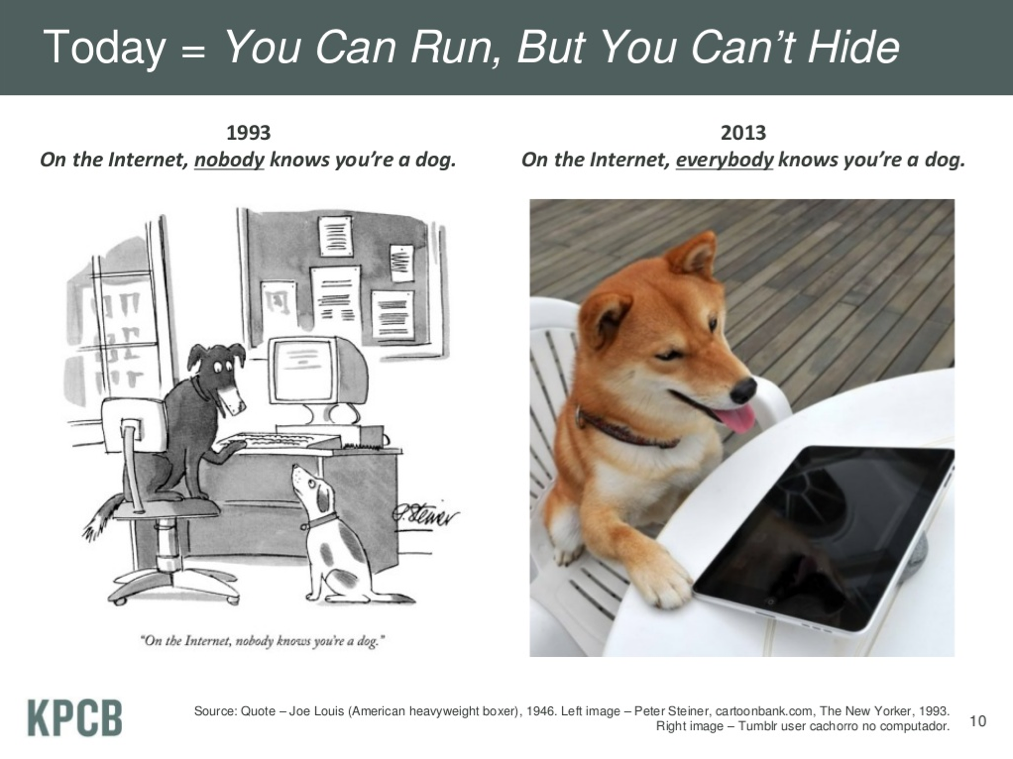Wow! For someone like me, the best thing about KPCB partner Mary Meeker’s annual Internet Trends presentation is it’s just packed with data. The charts are sometimes too packed, in fact, and more than one viewing is a must to take it all in. But it’s always revealing, and usually challenges a mental frame or two because it is research based, not fiction.
Comprehensive look
The scope of the presentation is comprehensive (117 slides worth) and much of it confirms what you have read elsewhere. (Now you just have the facts to support your strategy.) But there are surprises too — either in a new frame for widely recognized data or in the implications of the accelerating rate of change.
15 Hot Takeaways
Here are the things that leapt out to me as having special implications for marketers and business owners using Internet technology to effect positive change.
- The US is now second in the number of Internet users although still number one in the population penetration percent. China is first. (slide 4)
- Advertisers need to increase mobile advertising spend to catch up to where their customers are spending their time. (slide 5)
- “80% of the top ten global Internet properties are ‘made in USA,’ while 81% of users are outside America.” Let that sink in. (slide 6)
- At the top of this post is my new favorite on the wide-open transparency of today’s Internet. (slide 10)
- The exponential growth in sharing continues for pictures and video, and now sound and data too. (slide 12)
- The potential impact on health outcomes from sharing behavior data is humongous. Are you listening policymakers? (slide 25)
- At 15% versus an average of 24% worldwide, “Americans are sharing underachievers.” I didn’t think it was possible to share more than the average American! True, the US residents lack the Internet privacy protections enjoyed by those in many other countries, but it doesn’t seem likely that rational caution suddenly emerged as a national trait. (And besides, the EU countries with their strong protections also share less.) Culturally there are more educated/less education, more individualistic and more collective countries on both sides of the sharing spectrum. Perhaps it’s related to the age of a country’s population, with younger populations much more comfortable sharing online. (Japan, with the world’s oldest population also shares the least.) Sharing has become a core strategy for companies of all sizes so marketers will need to understand the factors at play here. (slide 28)
- You knew mobile Internet use was growing, but you may be surprised to learn that worldwide it’s 15% of total global Internet traffic. Listening or reading many of the pundits, you may have thought it was much higher — which it may or may not be for your audiences. (slide 32)
- Tablets are disrupting the computer industry even faster than smartphones did. You knew that too, but one graph crystalizes the facts. (slide 45)
- After smartphones and tablets, a new pattern is emerging for devices called “wearables/drivables/flyables/scannables.” I have not seen elsewhere such a compelling collection of examples across industries with clear implications for disruption and obvious market opportunities. (slides 48-65)
- The section “Lots to learn from China” delivers just that with intriguing implications for public, private and nonprofit sectors. (slides 66-73)
- Also in the not-seen-elsewhere category is an intriguing graph in a section on connected entrepreneurs that shows a parallel path (or perhaps a synergy?) between the number of registered members on LinkedIn and the gross margins of public companies. (slide 78)
- Whatever your perspective on immigration, this section builds a strong case to support changes to current US immigration rules to prepare for a shortage of high-skilled workers. (slides 84-91)
- The usually-not-considered-sexy Appendix is a must-read for examples of traditional industries, functions and processes being re-imagined by Internet trends. The impact on large organizations, the financial services, education, and healthcare industries, as well as specific functions and roles in every sector are specifically touched on. (slides 92-117)
- In case you’re feeling overwhelmed by the volume and velocity of these trends, there’s a helpful list of Internet learning tools used by professionals worldwide to either create or deliver learning content for others or for personal learning. (slide 108)
Thankfully, just as my brain was feeling full, I saw my favorite learning tools listed so there would be no need to learn yet another something new just to keep up with how these trends will affect clients, partners, and friends.




15 Hot Takeaways from the Internet Trends 2013 Presentation | Change Conversations http://t.co/LBxlvr1yeO #MondayBlogs